Alisols
Table of contents
-
Introduction
-
Parent material and environment
-
Regional Distribution
-
Definition
-
Genesis
-
Characteristics of Alisols
a. Morphological characteristics
b. Physical characteristics
c. Chemical characteristics
-
Management and Use of Alisols
1. Introduction
|
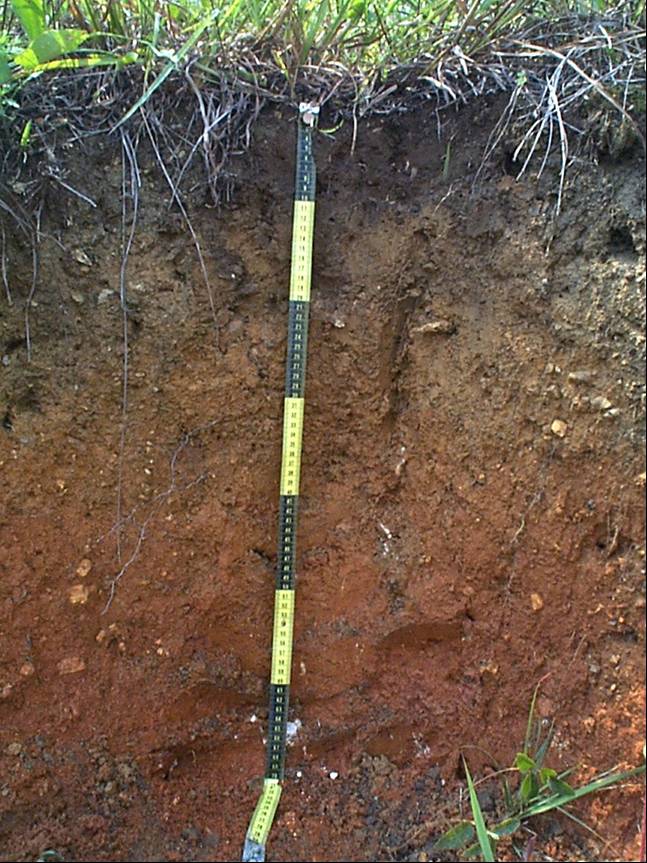 |
| Fig.1 Upland Alisol A(E)Bt |
| (
Source: web.utk.edu/~ammonst/ genesis.html) |
|
-
Alisols [Lat.: alum = aluminum] are strongly acid soils
of the humid tropics and subtropics with accumulation of high activity clays
(HAC) in the subsoil. Aluminum occupies more than 50 % of the exchange
complexes. The profile development mostly is ABtC.
-
They are internationally known as:
-
Brazil = Podzolicos vermelho-amarello a argila de
ativitade alta
-
Soil Taxonomy (USA) = Ultisols
-
France = Sols fersiallitiques tres
lessives
|
2. Parent material and environment
-
Parent material: Alisols can
form in a wide variety of parent materials having high-activity clay minerals
such as vermiculite and smectite. Most occurrences of Alisols reported so far
are on weathering products of basic rocks.
-
Environment: most common in old
land surfaces with a hilly or undulating topography, in humid (sub)-tropical
and monsoon climates.
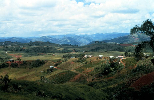 |
| Fig.2 Puerto Rico: Ferralsols occupy the flat landforms,
Alisols on the slopes |
| (
Source: Beinroth et al., 1996.) |
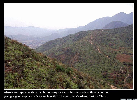 |
| Fig.3 Eastern China: hill region of
Yanshan |
| (
Source: FAO, 2001.) |
3. Regional Distribution
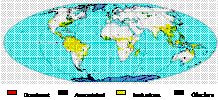 |
| Fig.4 Alisols worldwide |
| (
Source: FAO, 2001.) |
-
Worldwide, about 100 Mio. ha are used for agriculture in the
tropics (Driessen and Dudal, 1991). They are mainly found on old
erosion-surfaces with undulating topography and in warm-moist regions and
monsoon areas. Major occurrences of Alisols are found in
-
Latin-America (Ecuador, Nicaragua, Venezuela, Colombia,
Peru, Brazil)
-
Africa (West-Afrika and highlands East-Afrika,
Madagascar)
-
SE-Asia, China, Japan, SE-USA
-
Mediterranean area: old fluvial terraces, relicts of
ancient humid periods
4. Definition
-
Must have an argic B horizon within 100 cm or within 200 cm
when loamy sand is above (see chapter
(
 clay
eluviation)
). clay
eluviation)
).
-
The argic horizon has
-
a
 CEC > 24
cmolc/kg (1 M NH4OAc solution
buffered to pH 7) CEC > 24
cmolc/kg (1 M NH4OAc solution
buffered to pH 7)
-
and the
 BS < 50 % BS < 50 %
-
Alic properties = very acid soil material with a high
Al-content between 25 – 100 cm
5. Genesis
-
Alisols form where ongoing hydrolysis of 2:1 layered minerals
(HAC) like smectites and vermiculites releases much Al. Where these minerals
come to the surface (outcrop in hilly topography), intensive leaching of Si and
basic cations takes place. Many Alisols occur on slopes where the erosion of
the surface (truncate) exposes the Bt.
 |
| Fig.5 Sideslope Alisol |
| (
Source: University of Tennessee Forestry Arboretum – Oakridge;
web.utk.edu/ ~ammonst/oakridgesideslopepit6.jpg) |
-
Alisol-formation requires 3
steps:
-
Weathering of primary minerals and moderate leaching of Si.
These processes produce a
(
 saprolite)
with little weatherable primary
minerals and a dominance of HAC. The HAC are predomiantly smectitic on basic
rocks (e.g. basalt, andesite), and vermiculitic on more siliceous rocks such as
granite or gneiss. saprolite)
with little weatherable primary
minerals and a dominance of HAC. The HAC are predomiantly smectitic on basic
rocks (e.g. basalt, andesite), and vermiculitic on more siliceous rocks such as
granite or gneiss.
-
The second step involves the translocation of the clay
minerals to an argic B horizon: vertical (eluviation: only between pH 5 and
6.5)
(
 see chapter clay
eluviation)
or laterally. see chapter clay
eluviation)
or laterally.
-
The third step involves weathering of HAC and the release of
Al. HAC are unstable in environments that are depleted of silica and alkaline
earth cations. When weathering occurs in basic parent material with high amount
of Fe, Alisols have reddish color, e.g. rhodic Alisols (Caribbean)
 |
| Fig.6 Rhodic Alisol |
| (
Source: wapi.isu.edu/.../ EG_module_2_part2.html) |
6. Characteristics of Alisols
a. Morphological
characteristics
-
Most Alisols have an ochric surface horizon (= light-colored,
thin, low SOM of 0.6 %) see
 LECTURE NOTES ON
THE MAJOR SOILS OF THE WORLD LECTURE NOTES ON
THE MAJOR SOILS OF THE WORLD
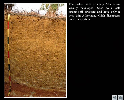 |
| Fig.7 Alisol with thin A horizon |
| (
Source: FAO, 2001.) |
but darker umbric horizons can be expected under
forest.
 |
| Fig.8 Alisol under natural vegetation in
Indonesia |
| (
Source: FAO, 2001.) |
-
The soil structure is rather weak in the surface horizon
because biological activity is hindered by the strong acidity and high Al
concentration. Less humus content is present in surface soil.
 |
| Fig.9 Alisol under sparse vegetation in
Indonesia |
| (
Source: ISRIC, NL.) |
-
The surface horizon overlies a dense argic subsurface horizon
that may hinder deep percolation of water. The structure of the argic horizon
is clearly more stable than that of the surface soil.
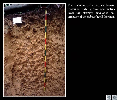 |
| Fig.10 Strong developed structure of B
horizon |
| (
Source: FAO, 2001.) |
b. Physical characteristics
-
The physical characteristics of Alisols are directly related
to the relative contents of HAC, LAC and Fe-oxides. Where shrink-swell minerals
dominate, the formation of vertic properties/horizons is favored. These Alisols
have BS > 50 %.
-
In many Alisols, textural differentiation between surface and
subsurface horizons imparts different physical properties. Surface horizons
tend to have an unstable structure (slaking) and reduced permeability, in
particular where the subsoil is consolidated. This delays internal drainage and
intensifies erosion at slopes.
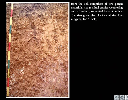 |
| Fig.11 Alisol with typical angular blocky soil
structure |
| (
Source: FAO, 2001.) |
c. Chemical characteristics
-
In many Alisols, toxic quantities of Al are present whereas
other plant nutrients are low and unbalanced. Exchangeable Al often is between
7-10 cmolc/kg. By comparison Ferralsols have 1
cmolc/kg of exchangeable Al.
-
However, some Alisols have good nutrient availability
(favorable cation exchange properties (when high HAC content). The mineral
reserves of Alisols are conditioned by the clay fraction and depend largely on
the composition of HAC that act as weatherable minerals in the system.
(
 see chapter clay
minerals) see chapter clay
minerals)
7. Management and Use
-
Generally, Alisols are unproductive soils. Alisols occur
predominantly on old land surfaces with hilly or undulating topography. The
generally unstable surface soil of Alisols makes them susceptible to erosion.
Toxic levels of Al at shallow depth and poor natural soil fertility are added
constraints. Some cropping systems are shown here:
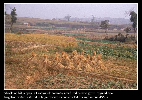 |
| Fig.12 Alisols on hill slopes in Eastern China are
terreced and use to grow irrigated rice |
| (
Source: ISRIC, NL.) |
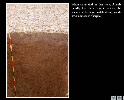 |
| Fig.13 Lose of organic matter |
| (
Source: ISRIC, NL.) |
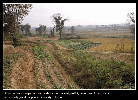 |
| Fig.14 Other common crops on these soils are
buckwheat, millet, peanuts and tea |
| (
Source: ISRIC, NL.) |
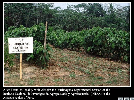 |
| Fig.15 A well-studied locality with Alisols in the
Amazon region of Peru |
| (
Source: ISRIC, NL.) |
-
There use is restricted to acid-tolerant crops as tea,
rubber, oil palm, cassava, cowpea, potato and traditional adapted rice
cultivars (unless fertilization and liming). Aluminum-sensitive plants are
maize, wheat and soybean.
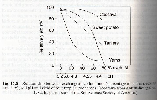 |
| Fig.16 Relationship between aluminium, soil pH and
yield of four root crops |
| (
Source: Marschner, 1995.) |
-
Management strategies for the amelioration of Al-toxicity
include the application of mulch
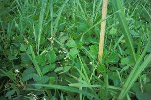 |
| Fig.17 Pueraria phaseoloides is used as cover
crop |
|
or green manure to increase SOM. Soil organic
matter (fulvic acid, organic acids) complexes Al in non-exchangeable forms and
ameliorates the phytotoxicity of Al-species on root growth.
-
Liming is another strategy to overcome or eliminate
Al-toxicity for plants (Al impairs root development). The application of liming
materials such as CaCO3, Ca(OH)2,
CaO und MgCO3 raise the pH of soils
[Colloid-H+ + CaCO3 ->
Colloid-Ca + H2O + CO2] above 5.4
so that no free Al is existent.
(
 see chapter
Al toxicity) see chapter
Al toxicity)
-
However, in many cases lime must be added in large enough
quantities
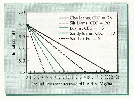 |
| Fig.18 Limestone requirement of soil with several
different texture (and therefore with different buffering capacities) to raise
pH to 6.5. Note: in warmer regions the SOM levels are lower and kaolinite often
predominates, hence the amount of lime would be ½ or 1/3 of those indicated
here (Brady and Weil, 2002). |
| (
Source: Brady and Weil, 2002.) |
and many small-scale farmers cannot afford the
costs of liming.
-
For most purposes, amelioration will be achieved if the pH is
raised just enough to eliminate exchangeable Al. This attempt (rather than
achieve a certain pH) is appropriate for highly weathered soils (Ferralsols,
Alisols). Using this approach, the amount of lime can be calculated
using
-
values for the initial CEC
-
the Al saturation (%)
-
An often used formula to determine lime requirement (Cochrane
et al. 1980) is: tons CaCO3/ha = 1.8 [Al – RAS
(Al+Ca+Mg)] / 100, where
-
RAS = desired % Al saturation
-
Al, Mg, Ca = cmolc/kg of each
exchangeable cation (from van Wambeke, 1992).
|

 previous | next
previous | next

 previous | next
previous | next